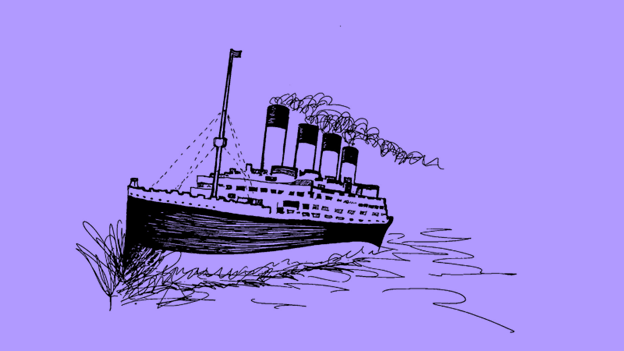What if *we* turned this ship around? (Part 2)

The Titanic was political from the moment the cold ocean water closed over its stern. The sinking of the world’s largest ship was a seismic blow to the Edwardian understanding of man’s (emphasis on he/him) power over nature. By the time the survivors landed in New York, politicians on both sides of the Atlantic had already begun to organize official inquiries. Change happened fast.
By the end of the year (1912), U.S. Congress passed legislation requiring all ships to maintain a constant radio presence to monitor for distress signals. Meanwhile, shipping companies scrambled to equip their vessels with lifeboats for all, retrofit double-bottomed hulls to extend halfway up the sides, and mandate lifeboat drills.
And by 1914, a treaty had been negotiated, drafted, and adopted, codifying many of these safety standards into international law, and establishing the International Ice Patrol to monitor icebergs in the North Atlantic.
A week after Germany’s national elections, Hamburgers went to the polls again. Overnight, the old posters of national candidates came down from the lampposts, trees, and makeshift billboards in our neighborhood, and up went the faces of their local counterparts.
Hamburg’s election held few surprises. The far-right AfD increased its vote share, just as it had in the national elections—but here, only to 7.5% of the vote. The city-state of Hamburg remains a liberal stronghold: the center-left SPD and the Greens will likely renew their governing coalition.
The only surprise was Die Linke (literally, “The Left”). In both the national and local elections, it outperformed the polls significantly. In fact, it was the only major left-of-center party to increase its vote share. And it won more votes from 18 – 24 year-olds than any other party.
I was not surprised.
Look, I’m the opposite of an expert when it comes to German politics. But as an outsider, fresh off the plane in January, wandering a city plastered in political posters, I was struck by Die Linke. Its strategy seemed different from the other parties’.
Take a closer look at the poster in the bottom-right corner of the collage above:

English, translated with Danny’s help:
Housing’s going to be a home game
Let's: Make housing construction a state responsibility, because housing is a fundamental right. Pay 6 euros per square meter, because rent will only have to cover maintenance. Transform corporations oriented toward profit into those oriented toward the public good. So we don’t have to spend half our lives working just to make rent. And implement here in Hamburg what Berlin is still waiting for.
Hamburg votes: How about a really strong left?
Setting aside the content and policy specifics (and however you might feel about them), this is strategically fascinating. American elections consultants would clutch their pearls at the number of words on this poster, and at the audacity of saying so clearly what the party actually stands for.
Compare this with, say, the Greens’ poster above: Smarte Schule, klasse Zukunft. “Smart school, classy future.” (Class/classy pun intentional in the German.) Some of their messaging was even more generic. A giant digital ad outside our nearby train station featured a picture of a candidate with the slogan, “In Hamburg, we vote Green.”
Of course, Die Linke wasn’t campaigning to win a majority in this election, or, like the Greens, to maintain a governing coalition. Die Linke was campaigning to come back from a bruising few years, including losing half its base to a breakaway faction. But more than that, Die Linke seems to be campaigning to rebuild on a much longer time horizon.
Because what’s even more interesting to me is how Die Linke’s strategy went beyond the messaging. Their posters also promoted events—yes, party meetings, but also cultural and educational events and even a “techno table tennis” event with free drinks and tacos. (I swear I saw posters for a dance party sponsored by Die Linke when we first arrived here, but I can’t seem to find it online.) Die Linke even advertises a free counseling service for “difficult life situations” like housing trouble, applying for disability benefits, and utility cut-offs. Throughout all their activities, as a minority opposition party, they’re engaging people around a set of clear demands for those in power.
In other words, Die Linke seemed, and still seems, to be organizing.
What do I mean by “organizing”? To paraphrase Marshall Ganz, organizing is weaving together relationships, education, and action to build grassroots power. Then channeling that power into focused campaigning that changes the trajectory of a community or a people for the better.
In other words, organizing is meeting ordinary people where they’re at; talking about issues that matter; and getting those people involved, in a deep way, to change those issues.
On Saturday, people rallied across the U.S. to say “Hands Off!” to Trump and Musk. (People also rallied in a dozen cities outside the U.S., including Berlin, but not here in Hamburg.) From afar, I played a miniscule role helping recruit attendees on behalf of my organization. That meant that, for the past few weeks, I’ve been following several internal listservs with the main organizers driving these events.
As the day approached, it was evident that this was going to be big—more than 1,300 events registered in all 50 states and DC—but unclear exactly how big. In the end, it shattered expectations.
More than one million people turned out for the largest mass demonstration since Trump was reinaugurated. The big cities were flooded with crowds of human beings. The videos from back home in Boston give me a sense of pride and hope—all 50 acres of the Boston Common seemingly packed shoulder to shoulder. But it’s the images from places like Topeka, KS, and Corning, NY, of hundreds of people gathered in politically “deep red” places, that I find really inspiring: a reminder that there are people everywhere who care.
From talking to friends and family back home, I can tell the day served an important purpose, as a direly needed injection of hope and energy, a reminder that we’re not alone, that we don’t have to roll over and play dead.
But as the rosy glow begins to fade; as the impacts of Trump’s tariffs come home to roost; as the barrage of bad news returns, replacing the invigorating protest images in our news feeds… I find myself wondering: Will we organize?
A mass mobilization checks the “action” box of organizing. It’s a moment—a moment that can portend a seismic shift underway, or at least the potential for one. But to make an impact, it needs to do the rest—it needs to live on, in long-term relationships and compounding, strategic actions that channel power into focused campaigning.
We can organize. And there are people across the U.S., and the world, organizing right now—organizing to move their elected officials, to return people home safely, to hold corporations to account, to implement bold local policy that proves what’s possible. I know some of those people, and I’m excited to write about them soon.
Because even more than Saturday’s rallies, I’m getting my biggest hits of hope from that organizing.
Here’s the thing: I don’t know for sure whether Die Linke’s grassroots organizing strategy made the difference in their showing in the German elections. In fact, credit almost certainly goes to a constellation of factors. And again, Die Linke didn’t win any governing power, and as long as the major political parties continue to refuse to form a coalition with them, they’re destined for the opposition. But they seem to have a longer-term, base-building strategy. Only time will tell if this strategy pays off.
But that’s also how grassroots organizing works: organizing takes time, and organizing rarely gets the credit when change does come. It’s usually overlooked or glossed over, when the journalists file their articles and the historians put down their pens.
In any story of social change, if we ask what might have happened if a group of ordinary people hadn’t shown up and started organizing, we can get a glimmer of how the outcome could have been very different. Especially in moments like this, when we can feel the rumblings of a seismic shift under our feet.
And the cool thing about organizing? Anyone can participate—and anyone can join in at any time, even if they never have before.
In my next post, I’ll explore the how.
If you’re already involved in organizing in your community, or know of local organizing that inspires you, I’d love it if you’d leave a comment or reply to this email to let me know about it. (Btw, the glitch was not fixed; if you’ve replied by email to any other post, I have not received it. But I should now!)
Love,
Ari
P.S. You guessed it: The bold changes that policymakers and company officials made in the aftermath of the Titanic disaster didn’t happen on their own.
At the White Star Line’s headquarters in Liverpool in the days after the sinking, the crowd of angry people was so large that representatives announced the list of casualties from an upper-floor balcony—then, no doubt, went inside to begin figuring out the changes to company policy that would satisfy public ire.
Meanwhile, while still aboard the Carpathia, second-class passenger Lawrence Beesley, a British science teacher, drafted a letter to the editor on behalf of a small group who “all felt that something must be done.” It was cabled to The Times of London immediately upon the ship’s arrival in New York and reprinted in The New York Times the following day. The letter urged policy changes including lifeboats for all passengers, mandatory boat drills, and reduced speed in known ice regions.
All three recommendations became international law in the 1914 maritime treaty.
What else:
- Just reading the text of Rebecca Solnit’s speech at the San Francisco Hands Off! rally left me breathless. “Be what happens.” Hell yeah.
- One way to plug in from here: The Rise for Freedom training series. Next one’s tomorrow evening. (Bonus: You may meet one or two of my colleagues!)
- Marge Piercy’s poem “The Low Road” is relevant inspiration for this moment.
- The take on Signalgate I didn’t know I needed.

Member discussion